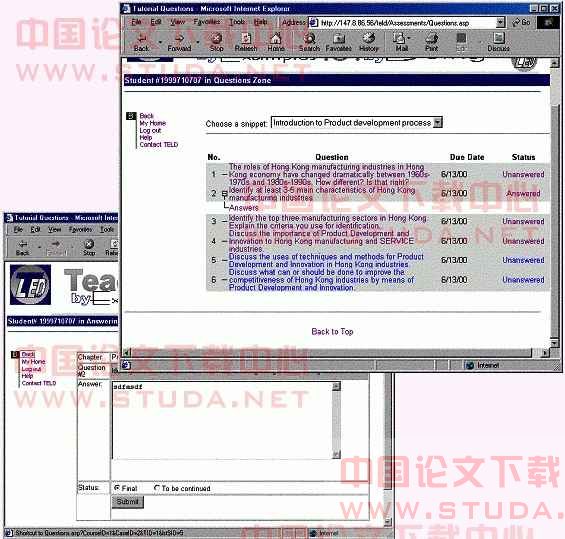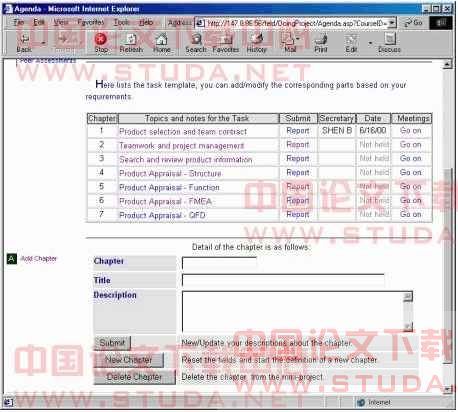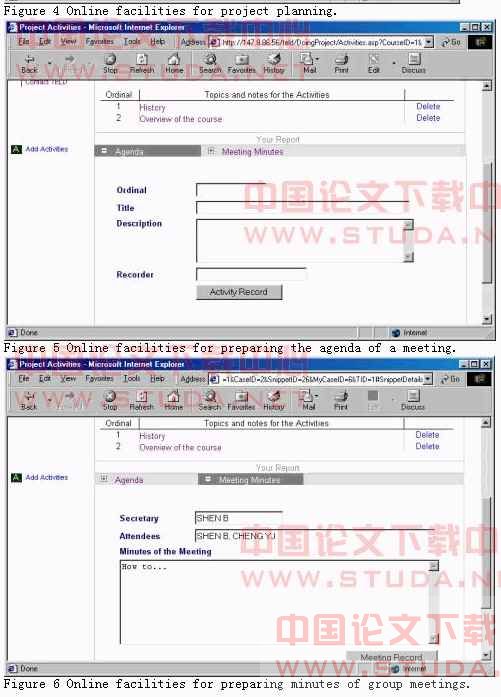3. participatory and collaborative learning with teld
participatory and collaborative learning can be understood from a number of viewpoints. firstly, the students must collaborate with the teacher(s) to establish their own learning objectives and plans of progress. the student is responsible for directing his or her own learning goals, methods and progress. secondly, students must participate in the analysis of the case study. during this process, students generate questions that need to be investigated and synthesize their answers to the discussion questions. thirdly, students must work together on issues that are given by the tutors or generated by the students themselves. individual members must participate in such teamwork.
collaborative and participatory learning are reinforced through various instruments. firstly, formal lectures are often unavoidable because of limited resources. the class size is usually large. it is therefore not too efficient to conduct too many discussions in this type of class. nevertheless, teld does provide some discussion questions that the teacher may wish to discuss during the formal lecture. secondly, workshops and seminars in small groups are organized for either tutorials or the mini-project. this is the time when students are expected to collaborate and participate intensively within the team or group. teld provides a number of facilities to facilitate group activities, e.g. for planning the learning activities, for posting questions in the project bullet board, and for submitting project progress reports. thirdly, participation from individual students is required through formative assessment (homework questions) after each formal lecture. finally, presentation is often used to groups to discuss their achievements in the project. the presentation is given jointly by the group and individual members must prepare their own materials to be presented.
this section focuses on the following four categories of teld facilities for supporting collaborative and participatory learning:
· participate in formative assessments as homework assigned after each lecture. tutors’ comments and marks can also be checked and observed.
· carry out summative assessments as a mini-project and submit the progress and final project reports online.
· prepare learning schedule of the mini-project and check the progress.
· organize group meetings and prepare minutes of meetings.

figure 3 online facilities for students to submitting answers to discussion questions.
3.1 use teld to answer homework questions
the purpose of formative assessment is mainly for the students to obtain timely feedbacks from the course tutors on specific topics / issues. marks allocated to formative assessments are therefore nominal and minimum. teld treats formative assessments as homework after formal lectures to force/encourage students to participate in the learning process. the assessment is individual in teld. a set of questions is attached to a topic or an example. the tutors specify the deadlines and students must answer them before the deadlines. students submit their answers online to the teld database. the course tutors will mark them and make comments online. both the students and tutors must login teld before they can answer questions and mark the answers.
figure 3 shows the sample screens of homework questions and online answering facilities. the entire process is straightforward. the following activities are involved:
· student login and choose a theme/topic to get the list of associated homework questions.
· choose a question by simply clicking on the question description. an answer book (page) is then provided.
· type the answer in the corresponding text box and submit the answer to the teld database.
· the student needs to indicate if the answer is completed. if completed, the answer will be available for tutors to mark. if not, the student may continue to answer the question at a later session.
· the tutor login teld and marks the answers and makes comments. (see previous section about the marking process in teld).
· the tutor also needs to indicate if the marking is final or to be continued. once the marking is final, the mark and comment will be available to the student to reflect. if not, the tutor needs to complete the marking at a later session.
· the student reflects on the theme/topic by looking at the answers, marks and comments.
3.2 use teld to upload exercise chapters for mini-project
as opposed to formative assessments which are usually individual, summative assessments are mainly for the “assessment” purpose. that is, marks allocated to these assessments constitute significant proportions of the overall mark. for some courses such as mechanics of solids, summative assessments consist of a series of independent exercises. for some courses such as product design and development, a mini-project is usually used. a mini-project in turn consists of a number of work packages which are actually treated as exercises in teld. in this sense, a mini-project is a series of logically related exercises. teld treats both forms of summative assessments in the same way. individual exercises are conducted and reports are submitted online separately as basic units. they are then put together to form a report based on which the tutors allocate marks.
in teld, students/groups of students are able to submit their answers to exercises online using the facilities shown in figure 4. as explained previously, an exercise has the exactly same structure in the backend teld database as that of the teaching example. therefore, the process of submitting an exercise is very similar to the process for the tutor to prepare lecture notes and specify exercises (huang et al, 2000b). however, the front-end user interface is different between that used by the tutors and that used by the students.
at present, teld does not support html format of exercise reports/chapters. instead, students are able to prepare their reports in original ms word or ms powerpoint formats. these reports will be uploaded into the teld database and become available for the tutors to mark.
teld does not impose any structure for preparing exercise chapters/reports. students are free to adopt their own ways of organizing the reports/chapters. if html format is to be allowed and supported in teld, it is intended and perhaps necessary for teld to provide a template report and chapter so that students can customize to suit their special needs while a reference structure is adopted. such template would include some items in the following:
3.3 use teld to prepare mini-project plan
as mentioned in the preceding section, the mini-project consists of a series of exercises. when the tutor defines the mini-project, he or she prepares a master project plan for students’ (groups’) reference only. this plan generally defines the start and due dates of individual exercises in the mini-project, in addition to the brief job specification. the groups must produce a slightly more detailed plan for the mini-project by specifying who is responsible for which exercise(s), what is the start and due date for each exercise, etc. the group’s project plan may and should deviate from the tutor’s reference plan, as long as the final due date is met.
figure 4 shows the sample screen of mini-project plan editor. as can be seen from the figure, the editor includes two main parts. the top part is a list of work packages (exercises) already included in the project. the lower part is a form for viewing, entering and modifying exercise definition information. the group is able to add new exercises or modifying an existing exercise. the process of both addition and modification is straightforward and almost self-explanatory by the user interface of the editor.


3.4 use teld to prepare agendas of group meetings
in teld, each exercise is addressed by a workshop or a meeting within the project team. for each meeting, an agenda is prepared. in teld, a meeting correspond to an exercise while each exercise (meeting) has one agenda although several workshops may be conducted in order to complete the exercise. items in an agenda correspond to the sections of cases (exercises). therefore, meetings are overall plan for the mini-project while agendas are detailed plans for individual meetings or exercises.
teld provides facilities for groups to arrange their meetings online. this is done through the teld agenda editor shown in figure . at the top of the agenda editor, the aim of the meeting is displayed. this is followed by a list of agenda items already included in the meeting. below the list is a form containing the detail of an agenda item. with this form, a new or existing item is added or modified respectively.
3.5 use teld to prepare minutes of group meetings
minutes of group meetings are progress reports of the mini-project. teld provides some online facilities for groups to prepare such progress reports in the form of minutes of meetings after they have finished the meetings. figure 6 shows the sample screen of the minute editor. the following activities may be involved in preparing the progress reports:
· choose the meeting to start the preparation.
· check the attendance of group members at the meeting.
· record what has been discussed and achieved at the meeting according to individual agenda items.
· note important issues arising from the discussion.
· produce the action list for the coming planning period
· submit the contents to the teld database.
3.6 use teld to leave messages on the course forum and project bulletin board
for each course, teld provides a forum for the students and tutor to post questions of concern and produce their answers to address these questions. similarly, for each project group, teld provides a bulletin board for members to leave important messages. the bulletin board and the course forum are similar in terms of the data structure and operation except for their scopes. the forum is for the entire course and it is accessible to all the project groups. in contrast, the bulletin board is shared by and only accessible to the project team. in practice, students may prefer to use mobile phones to contact each other instead of using the bulletin board and course forum. however, telephone conversations are informal and not recorded for future reference. for this reason, students are encouraged to use the bulletin board and the forum.
4. concluding discussions
student participation and collaboration are two key elements of the teld teaching and learning methodology. this paper has discussed how the teld courseware engine facilitates the student involvement and collaboration in the delivery of curriculum materials and the operation of the course with the example of “product engineering”. our initial experience and insights with teld have shown great potentials to be generalized and extended for other courses where the teld method is introduced. the teld functionality of enabling student participation and collaboration is unique when compared with those web-based systems developed and used by many faculties in-house and even with some commercial systems such as webct. as a virtual study room, teld provides facilities for the groups and teams to plan their learning activities, to indicate the roles and responsibilities of team members, and to indicate when and what individual members should do and how they should integrate their findings and works through teamwork in the form of workshops or meetings. although senior students have these project management skills, first year students need intensive guidance from tutors in this regard without the support of online teld. the use of the online teld engine to some extent resolves the requirement of intensive resources (tutor time and efforts) when the teld method is used.
like most commercial web-based online course tools such as webct (), eteaching solutions (), e-education (), and course info () are some of the examples widely used at colleges, teld host teaching and learning materials for both the teachers and students while provide facilities to enhance and improve the interactivity between the teachers and students. however, teld has its unique features. firstly, teld incorporates the teld methodology while most of the existing commercial systems do not. teld provide a case editor for compiling case studies. secondly, teld integrates the functions of search engine, web host and virtual classroom/study room into one framework. finally, teld emphasizes on collaborative learning with facilities for planning group activities. for example, facilities are provided for groups to prepare agendas and minutes of workshops / meetings.
although there may be additional activities or functions that should be incorporated into teld to enable student involvement and collaboration, they tend to be sufficient to support our own courses such as product engineering. the main remaining task is routine improvement to the usability of these existing facilities.
however, there is one important assumption made in teld. that is, teld assumes that curriculum materials are designed and hosted in an interactive way to support active teaching and participatory and collaborative learning. teld uploads and downloads the curriculum materials in their original forms (currently pdf, ms word and powerpoint files although other formats can also be supported) without any changes in the formats and contents. teld does not interfere with, nor influence the interactivity of, these original materials. technically, there are various techniques regarding how to incorporate and enhance the interactivity of course materials. the actual implementation however depends on the contents of the subject matters. for this reason, the responsibility of ensuring interactivity must rely mainly on individual providers of course materials.
acknowledgements
this work has been financially sponsored through a teaching development grant from the university of hong kong and hong kong university grant committee.
references
/ there are huge number of references in the literature on case method, problem-based learning, and project-based learning. this paper only uses some representative web sites for these methods. a comprehensive list of references is given under the “resources” at .
http://about.webct.com/library/v3_white.html
http://edweb.sdsu.edu/clrit/learningtree/pbl/whatispbl.html
/foundation/pbl/
/
barnes, l.b., chistensen, c.r., hansen, a.j. (1994) teaching and the case method, published by harvard business school press, third edition.
erskine, j.a. leenders, m.r., mauffette-leenders, l.a. (1998) teaching with cases, school of business administration, the university of western ontario.
huang, g.q., shen, b. mak, k.l. (2000a) “: online courseware engine for teaching by examples and learning by doing”, technical report imse2000-gqh-teld01, department of industrial and manufacturing systems engineering, university of hong kong, hong kong. also submitted to international journal of computers and education.
huang, g.q., shen, b. mak, k.l. (2000b) “electronic delivery of curriculum materials with the online teld courseware engine”, technical report imse2000-gqh-teld02, department of industrial and manufacturing systems engineering, university of hong kong, hong kong. also submitted to ieee transactions on education.
huang, g.q., shen, b. mak, k.l. (2000c) “participatory and collaborative learning with teld courseware engine”, technical report imse2000-gqh-teld04, department of industrial and manufacturing systems engineering, university of hong kong, hong kong. also submitted to asce journal of professional issues in engineering education and practice.
johnson, p.a. (1999) “problem-based, cooperative learning in the engineering classroom”, american society of civil engineers journal of professional issues in engineering education and practice, january 1999, 8-11.
johnson, d.w., johnson, r.t. (1988) “impact of cooperative-team learning on performance and retention”, report number n00014-87-k-9218, cooperative learning centre, minnesota university, minneapolis, minnesota.
mourtos, n.j. (1986) “the nuts and bolts of cooperative learning in engineering”, journal of engineering education, 86 (1), 35-38.
wiggins, r. (1995). growth of the internet: an overview of a complicated subject [on-line]. available: http://www.msu.edu //staff/ rww/netgrow.html

